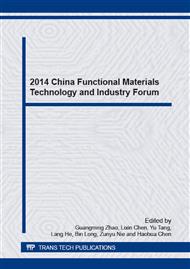[1]
C. Feldmann, T. Jüstel, C.R. Ronda, P.J. Schmidt, Inorganic luminescent materials: 100 years of research and application , Adv. Funct. Mater., Vol. 13 (2003) No. 7, p.511.
DOI: 10.1002/adfm.200301005
Google Scholar
[2]
Y. Kojima, S. Kamei, N. Nishimiya. Preparation and fluorescence property of red-emitting Eu3+-activated amorphous calcium silicate phosphor, Materials Research Bulletin, Vol. 45 (2010) No. 2, p.121.
DOI: 10.1016/j.materresbull.2009.09.032
Google Scholar
[3]
M. Mikami, N. Kijima,B. Bertrand, M. Stankovski,X. Gonze, Theoretical approach for white-LED phosphors: from crystal structures to optical properties, Materials Science and Engineering, Vol. 18(2011) No. 10, p.1.
DOI: 10.1088/1757-899x/18/10/102001
Google Scholar
[4]
S. Nishiura, S. Tunabe, K. Fujioka, Y. Fujimoto, Properties of transparent Ce: YAG ceramic phosphors for white LED, Optical Materials, Vol. 33 (2011) No. 5, p.688.
DOI: 10.1016/j.optmat.2010.06.005
Google Scholar
[5]
Q.L. Dai, M.E. Foley, C.J. Breshike, A. Lita and G.F. Strouse, Ligand-passivated Eu: Y2O3 nanocrystals as a phosphor for white light emitting diodes, Journal of the American Chemical Society, Vol. 133 (2011) No. 39, p.15475.
DOI: 10.1021/ja2039419
Google Scholar
[6]
C.C. Lin R.S. Liu, Advances in phosphors for light-emitting diodes, The Journal of Physical Chemistry Letters, Vol. 2 (2011) No. 3, p.1268.
Google Scholar
[7]
Y. Yan F.B. Cao Y.W. Tian and L.S. Li. Improved luminescent properties of red-emitting Ca0. 54Sr0. 16Gd0. 12(MoO4)0. 2(WO4)0. 80 phosphor for LED application by charge compensation, J ournal of Luminescence, Vol. 131 (2011) No. 6, p.1140.
DOI: 10.1016/j.jlumin.2011.02.022
Google Scholar
[8]
G.R. Dillip S.J. Dhoble,L. Manoj,C. MadhukarReddy, B. DevaPrasadRaju. A potential red emitting K4Ca(PO4)2: Eu3+ phosphor for white light emitting diodes. Journal of Luminescence, Vol. 387 (2004) No. 1, p.2.
DOI: 10.1016/j.jlumin.2012.06.029
Google Scholar
[9]
S. Neeraj, N. Kijima, A.K. Cheetham. Novel red phosphors for solid-state lighting: the system NaM(WO4)2−x(MoO4)x: Eu3+ (M= Gd, Y, Bi), Chemical Physics Letters, Vol. 182 (2009) No. 14, p.203.
DOI: 10.1016/j.cplett.2003.12.130
Google Scholar
[10]
M. Thomas, P. PrabhakarRao, M. Deepa, M.R. Chandran, P. Koshy. Novel powellite-based red-emitting phosphors: CaLa1-xNbMoO8: xEu3+ for white lightemitting diodes, Journal of Solid State Chemistry, Vol. 182 (2009) No. 14, p.203.
DOI: 10.1016/j.jssc.2008.10.015
Google Scholar
[11]
J. Sytsma, A. Meijer, G. Blasse, Spectroscopy of Gd3+ and Eu3+ in the calcite structure, J. Solid State Chem., Vol. 99 (1992) No. 1, p.78.
DOI: 10.1016/0022-4596(92)90291-3
Google Scholar
[12]
Y. Kojima, S. Doi, T. Yasue, Synthesis of europium (II) doped calcium carbonate phosphor under coexisting ammonium chloride and its fluorescence property, J. Ceram. Soc. Jpn., Vol. 111(2003) No. 1293, p.343.
DOI: 10.2109/jcersj.111.343
Google Scholar
[13]
B. Zhou, B. S Liu, H.F. Zou, et al. Facile synthesis of cubic and spindle-shaped CaCO3 particles and their applications as red phosphor doped with Eu3+, Colloids Surf., Vol. 447 (2014) No. 1, p.166.
DOI: 10.1016/j.colsurfa.2013.12.078
Google Scholar
[14]
Y. Kojima, K. Machi, T. Yasue, Y. Arai, Synthesis of Ce3+ and Mn2+ codoped calcium carbonate phosphor emitting by black light irradiation and its fluorescence property, J. Ceram. Soc. Jpn., Vol. 108 (2000) No. 9, p.836.
DOI: 10.2109/jcersj.108.1261_836
Google Scholar
[15]
L. Hu, Z. Mao, C. Gao, Fabrication of fluorescent microparticles by doping water-soluble CdTe nanocrystals into calcium carbonate for monitoring intracellular uptake, Colloids Surf., Vol. 336(2009) No. 1, p.115.
DOI: 10.1016/j.colsurfa.2008.11.031
Google Scholar
[16]
Z. Lu, L. Chen, Y. Tang, Y. Li, Preparation and luminescence properties of Eu3+-doped MSnO3(M=Ca, Sr and Ba) perovskite materials, J. Alloys Compd., Vol. 387 (2005) No. 1, p. L1.
DOI: 10.1016/j.jallcom.2004.06.036
Google Scholar
[17]
T. Katsumata, K. Sasajima, T. Nabae, Characteristics of strontium aluminate crystals used for long-duration phosphors , J. Am. Ceram. Soc., Vol. 81 (2005) No. 2, p.413.
DOI: 10.1111/j.1151-2916.1998.tb02349.x
Google Scholar
[18]
M. Yang, Q. Huang, X.Q. Jin. Facile synthesis of the assembled hexagonal vaterite plates and the application as red phosphor doped with Eu3+ ions, Colloids and Surfaces A: Physicochem. Eng. Aspects, Vol. 386 (2011) No. 1, p.87.
DOI: 10.1016/j.colsurfa.2011.06.028
Google Scholar
[19]
S.P. Bao, X.Y. Chen, Z. Li, B.J. Yang, Y.C. Wu, Effects of solvent and additive on controllable mineralization of MCO3 (M = Ca, Ba Sr) crystals and their applications as red phosphors doped with Eu3+ ions, CrystEngComm., Vol. 13 (2011).
DOI: 10.1039/c0ce00794c
Google Scholar
[20]
Y.X. Pan, M.M. Wu, Q. Su. Synthesis of Eu3+ doped calcium and strontium carbonate phosphors at room temperature, Mater Res Bull, Vol. 38 (2003) No. 9, p.1537.
DOI: 10.1016/s0025-5408(03)00174-0
Google Scholar
[21]
M. Kang, J. Liu, G. Yin, S. Rong, Preparation and characterization of Eu3+-doped CaCO3 phosphor by microwave synthesis, Rare Met., Vol. 28 (2009) No. 5, p.439.
DOI: 10.1007/s12598-009-0085-4
Google Scholar
[22]
A. Birkel, N. A. DeCino, N.C. George, K.A. Hazelton, B.C. Hong, R. Seshadri. Eu2+-doped M2SiO4 (M =Ca, Ba) phosphors prepared by a rapid microwave-assisted sole-gel method: Phase formation and optical Properties, Solid State Sciences, Vol. 19 (2013).
DOI: 10.1016/j.solidstatesciences.2013.02.003
Google Scholar
[23]
R. Sun, W.Q. Yan, J. Liu, et al. Hydrothermal synthesis of red phosphors CaCO3: Eu3+, Joural of the chinese ceramic society, Vol. 38(2010) No. 2, p.332.
Google Scholar
[24]
T.R.N. Kutty, M. Nayak, Photoluminescence of Eu2+-doped mullite(xAl2O3·ySiO2; x/y = 3/2 and 2/1) prepared by a hydrothermal method, Mater. Chem. Phys., Vol. 65 (2000) No. 2, p.158.
DOI: 10.1016/s0254-0584(00)00232-7
Google Scholar
[25]
F.Q. Ren, D.H. Chen. A promising red-emitting phosphor for white-light-emitting diodes prepared by a modified solid-state reaction, Optics & Laser Technology, Vol. 42 (2010) No. 1, p.110.
DOI: 10.1016/j.optlastec.2009.05.005
Google Scholar
[26]
F.W. Mo, L.Y. Zhou, Q. Pang, F.Z. Gong, Z.J. Liang. Potential red-emitting NaGd(MO4)2: R(M= W, Mo, R=Eu3+, Sm3+, Bi3+) phosphors for white light emitting diodes applications, Ceramics International, Vol. 38 (2012) No. 8, p.6289.
DOI: 10.1016/j.ceramint.2012.04.084
Google Scholar
[27]
W.J. Park, M.K. Jung, S.M. Kang, T. Masaki, D.H. Yoon, Synthesis and photoluminescence characterization of Ca3Si2O7: Eu2+ as a potential green-emitting white LED phosphor,J. Phys. Chem. Solids, Vol. 69 (2008) No. 5, p.1505.
DOI: 10.1016/j.jpcs.2007.10.093
Google Scholar
[28]
I.M. Nagpure,S. Saha S.J. Dhoble. Photoluminescence and thermoluminescence characterization of Eu3+- and Dy3+ -activated Ca3(PO4)2 phosphor, Journal of Luminescence, Vol. 129 (2009) No. 9, p.898.
DOI: 10.1016/j.jlumin.2009.03.034
Google Scholar


